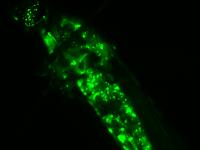
Anopheles gambiae mosquito infected with GFP-expressing AgDNV. Researchers at the Johns Hopkins Bloomberg School of Public Health's Malaria Research Institute have identified a previously unknown virus that is infectious to Anopheles gambiae—the mosquito primarily responsible for transmitting malaria. According to the researchers, the discovered virus could one day be used to pass on new genetic information to An. gambiae mosquitoes as part of a strategy to control malaria, which kills over one million people worldwide each year. The study was published August 22 online in the peer-reviewed open access journal PLoS Pathogens.
The virus, AgDNV, is a densonucleosis virus or "densovirus," which are common to mosquitoes and other insects, but do not infect vertebrate animals such as humans. Although the virus does not appear to harm the mosquitoes, the researchers determined it is highly infectious to mosquito larvae and is easily passed on to the adults.
According to Jason Rasgon, PhD, senior author of the study, the discovery came about serendipitously while the research team was conducting experiments to determine whether Wolbachia bacteria could be used to infect An. gambiae mosquito cells. During the analysis, Xiaoxia Ren, a postdoctoral fellow with Johns Hopkins Malaria Research Institute, noticed an "artifact," that appeared as a prominent band in the gel used to detect the bacteria.
"Finding artifacts such as this one during experiments is not uncommon, but we decided to investigate this one further since we kept observing it over and over. When we sequenced it we were surprised to learn that we had found a new virus," explained Rasgon, an assistant professor with the Bloomberg School's W. Harry Feinstone Department of Molecular Microbiology and Immunology.
According to Rasgon, the virus could be potentially altered to kill the mosquito or make An. gambiae incapable of transmitting malaria. To test the concept, the research team successfully used altered AgDNV to express harmless green fluorescent protein in the adult mosquitoes which could be easily spotted under the microscope.
"In theory, we could use this virus to produce a lethal toxin in the mosquito or instruct the mosquito to die after 10 days, which is before it can transmit the malaria parasite to humans. However, these concepts are many years away," said Rasgon.
Source : Johns Hopkins University Bloomberg School of Public Health
 Print Article
Print Article Mail to a Friend
Mail to a Friend
